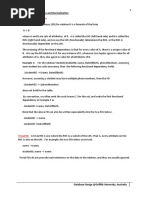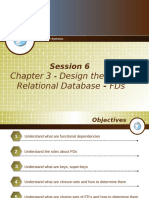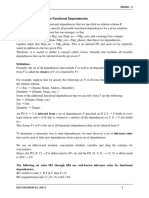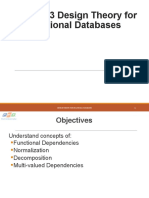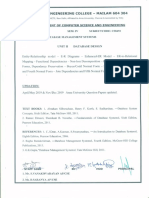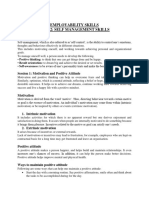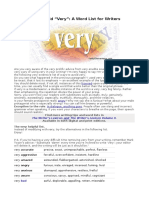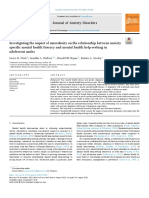DBMS Module 2.3 Functional Dependency
Uploaded by
Shraddha PattnaikDBMS Module 2.3 Functional Dependency
Uploaded by
Shraddha PattnaikDBMS module 2.
Functional Dependency
Database Engineering 4th CSE
FD
• Functional Dependencies are constraints in the set of legal
relations.
• It plays an important role in database design.
• FDs are constraints that are derived from the meaning
and interrelationships of the data attributes.
• FD is denoted by X Y, between two sets of attributes X
and Y. we say that “X (functionally) determines Y”
• X may also be called a determinant
Database Engineering 4th CSE
FD
• A set of attributes X functionally determines a set of
attributes Y if the value of X determines a unique value for
Y
• X Y holds if whenever two tuples have the same value for
X, they must have the same value for Y
If t1[X]=t2[X], then t1[Y]=t2[Y] in any relation instance
r(R)
• X Y in R specifies a constraint on all relation instances
r(R)
• FDs are derived from the real-world constraints on the
attributes
Database Engineering 4th CSE
SSN EName PNumber PName PLocation Hour age
0001 Ram A123 Security BBSR 8 29
0002 Ravi A123 Security BBSR 5 30
0003 Shyam B231 DBA RKL 9 28
0001 Ram B231 DBA RKL 4 29
0002 Ravi B231 DBA RKL 5 30
0002 Ravi A123 Security BBSR 6 30
Database Engineering 4th CSE
Example of FD
• Social Security Number determines employee
name
SSN ENAME
• Project Number determines project name and
location
PNUMBER {PNAME, PLOCATION}
• Employee SSN and project number determines
the hours per week that the employee works on
the project
{SSN, PNUMBER} HOURS
Database Engineering 4th CSE
Alternate definition of FD
• R satisfies X → Y if whenever two tuples in
any instance of R have the same X-value,
they must also have the same Y-value.
• R satisfies X → Y if each distinct X-value
corresponds to a unique Y-value in any r(R).
Database Engineering 4th CSE
Which FD is satisfied?
• Which FD does R(A, B, C, D) satisfy, if the
following instance is the only instance of R?
D → B,
R
A B C D A → C,
A1 B1 C1 D1 AB → D
A1 B2 C1 D2
A2 B2 C2 D2
A2 B3 C2 D3
A3 B3 C2 D4
Database Engineering 4th CSE
Full Functional Dependency
• A full functional dependency occurs when you already
meet the requirements for a functional dependency and
the set of attributes on the left side of the functional
dependency statement cannot be reduced any farther.
• Given a relation R and Functional Dependency X→Y
Y is fully functionally dependent on X and there should
not be any Z→Y, Where Z is a proper subset of X.
• For example, “{SSN, age} -> name” is a functional
dependency, but it is not a full functional dependency
because you can remove age from the left side of the
statement without impacting the dependency
relationship.
Database Engineering 4th CSE
Trivial FD
• A functional dependency FD: X → Y is
called trivial if Y is a subset of X.
• i.e Y ⊆ X.
• Example:
• A → A, AB → A
Database Engineering 4th CSE
Inference Rules for FDs
• Given a set of FDs F, we can infer additional FDs
that hold whenever the FDs in F hold
• Armstrong's inference rules also called
Armstrong’s axioms
A1. (Reflexive) If Y ⊆ X, then X Y
A2. (Augmentation) If X Y, then XZ YZ
(Notation: XZ stands for X U Z)
A3. (Transitive) If X Y and Y Z, then X Z
• A1, A2, A3 form a sound and complete set of
inference rules
Database Engineering 4th CSE
Armstrong's Axioms
1. Reflexivity Rule
– If X is a set of attributes and Y is a subset of X, then
X → Y holds.
– Each subset of X is functionally dependent on X.
2. Augmentation Rule
– If X → Y holds and W is a set of attributes, then
WX → WY holds
– If Y is determined by X then a set of attributes W and Y
together will be determined by W and X together
3. Transitivity Rule
– If X → Y and Y → Z hold, then X → Z holds
– If X functionally determines Y and Y functionally
determines Z then X functionally determines Z.
Database Engineering 4th CSE
Additional Useful Inference Rules
1. Decomposition
– If X YZ is FD, then X Y and X Z are
FD
2. Union
– If X Y and X Z, then X YZ is FD
3. Psuedotransitivity
– If X Y is FD and WY Z is FD, then WX
Z is FD
Database Engineering 4th CSE
Closure of a set of FD
• Let F be a set of functional dependencies.
The closure of F is the set of all functional
dependency logically implied by F.
+
• We denote the closure of F by F .
+
• We can find the F given F by using the
Inference rules.
Database Engineering 4th CSE
• R=(A, B, C, D, E) and FDs are:
A → BC
CD → E
B→D
E→A
Sol:
E → A, A → BC ,so E → BC using transitivity rule.
CD→ E, E → A ,so CD → A using transitivity rule.
A→ BC, A → B ,so A → C using decomposition rule.
B → D, CD → E ,so BC → E using pseudotransitivity.
Database Engineering 4th CSE
Compute the closure of given set
• Closure of Attribute Sets:
• Let R is a relation schema with set of FDs F.
• Let X is a set of attributes
• The closure of attribute set X under a set of
+
F and it denoted by X
Database Engineering 4th CSE
Compute the closure of given set
Algorithm of X + based on F
Input: A set of FDs and set of attribute X.
Output: The closure of X i.e. X + under F
set Result = X
Repeat until Result doest not change.
For each FD A → B in F
If A ⊆ Result then
Result = Result ∪ B
end
Database Engineering 4th CSE
Compute the closure of given set
• R=(A, B, C, D, E) and FDs are:
A → BC
CD → E
B→D
E→A
find Closure of A, B, C, D, CD
+
Sol: A = {A, B, C, D, E}
+
B = {B, D}
+
C = {C}
+
D = {D}
+
CD = {C, D, E, A, B}
Database Engineering 4th CSE
Compute the closure of given set
• R=(A, B, C, G, H, I) and FDs are:
A→B
A→C
CG → H
CG → I
B→H
find Closure of A, B, CG
+
Sol: A = {A, B, C, H}
+
B = {B, H}
+
CG = {C, G, H, I}
Database Engineering 4th CSE
Compute Candidate Key
• Determine each set of attribute X for which
the left hand side of any FD in F must be a
subset of X.
+
• Compute X under the given set of FD in F.
+
• If X = {R} then X is a candidate key of R .
Database Engineering 4th CSE
Example
• R=(A, B, C, D, E, F, G, H, I, J) and FDs are:
A B→ C
A → DE
B→ F
F → GH
D→IJ
find the candidate key of R
Sol: A + = {A, D, E, I, J}
B + = {B, F, G, H}
D + = {D, I, J}
F + = {F, G, H}
AB + = {A, B,C, D, E, F, G, H, I, J} //AB is the candidate key
Database Engineering 4th CSE
Prime and Non Prime Attribute
• An attribute A in a relation schema R is a
prime attribute if A is part of any candidate
key of the relation .
• If A is not part of any candidate key of R,
then A is called non prime attribute or non
prime.
Database Engineering 4th CSE
Partial Dependency
• If any proper subsets of the key determine any of
the non-key attributes then there exist a partial
dependency.
• Example: Given A relation R(A,B,C,D,E) , Functional
Dependency : AB→CDE , Primary key(key) is AB.
• Then A→C : is a Partial Dependency
A→D : is a Partial Dependency
A→E : is a Partial Dependency
B→C : is a Partial Dependency
B→D : is a Partial Dependency
B→E : is a Partial Dependency
Database Engineering 4th CSE
Nonredundant Covers
• Let R is a relation schema with a set of FDs
F. Assume X → Y is a FD.
+ +
• Find out X under {F-(X → Y) FD, If X = {R }
then X → Y is redundant and remove the
redundant FD from F we got nonredundant
cover .
Database Engineering 4th CSE
Example
• R=(A, B, C, D, E, H) and FDs are:
A → BC
CD → E
E→ C
D → AEH
ABH → BD
DH →BC
find out non redundant cover
Sol: for CD → E
+
CD under {F-(CD → E)} = {A, B,C, D, E, H} = {R} so CD → E is redundant
for DH →BC
DH + under {F-(DH →BC)} = {A, B,C, D, E, H} = {R} so DH →BC
is redundant
Database Engineering 4th CSE
Canonical Cover
• Sets of functional dependencies may have
redundant dependencies that can be inferred from
the others
– For example: A → C is redundant in: {A → B, B → C}
– Parts of a functional dependency may be redundant
• E.g.: on RHS: {A → B, B → C, A → CD} can be simplified to
{A → B, B → C, A → D}
• E.g.: on LHS: {A → B, B → C, AC → D} can be simplified to
{A → B, B → C, A → D}
• Intuitively, a canonical cover of F is a “minimal” set
of functional dependencies equivalent to F, having
no redundant dependencies or redundant parts of
dependencies
Database Engineering 4th CSE
Extraneous Attributes
• Consider a set F of functional dependencies
and the functional dependency α → β in F.
– Attribute A is extraneous in α if A ∈ α
and F logically implies (F – {α → β}) ∪ {(α – A)
→ β}.
– Attribute A is extraneous in β if A ∈ β
and the set of functional dependencies
(F – {α → β}) ∪ {α →(β – A)} logically implies F.
• Note: implication in the opposite direction is
trivial in each of the cases above, since a
“stronger” functional dependency always
implies a weaker one
Database Engineering 4th CSE
Extraneous Attributes
• Example: Given F = {A → C, AB → C }
– B is extraneous in AB → C because {A → C,
AB → C} logically implies A → C (I.e. the
result of dropping B from AB → C).
• Example: Given F = {A → C, AB → CD}
– C is extraneous in AB → CD since AB → C
can be inferred even after deleting C
Database Engineering 4th CSE
Testing if an Attribute is Extraneous
• Consider a set F of functional dependencies and the
functional dependency α → β in F.
• To test if attribute A ∈ α is extraneous in α
1. compute ({α} – A)+ using the rest of dependencies in F
2. check that ({α} – A)+ contains β; if it does, A is
extraneous in α
• To test if attribute A ∈ β is extraneous in β
1. compute α+ using only the dependencies in
F’ = (F – {α → β}) ∪ {α →(β – A)},
2. check that α+ contains A; if it does, A is extraneous in β
Database Engineering 4th CSE
Canonical Cover
• A canonical cover for F is a set of dependencies Fc such that
– F logically implies all dependencies in Fc, and
– Fc logically implies all dependencies in F, and
– No functional dependency in Fc contains an extraneous attribute,
and
– Each left side of functional dependency in Fc is unique.
• To compute a canonical cover for F:
repeat
Use the union rule to replace any dependencies in F
α1 → β1 and α1 → β2 with α1 → β1 β2
Find a functional dependency α → β with an
extraneous attribute either in α or in β
If an extraneous attribute is found, delete it from α → β
until F does not change
• Note: Union rule may become applicable after some extraneous
attributes have been deleted, so it has to be re-applied
Database Engineering 4th CSE
Computing a Canonical Cover
• R = (A, B, C)
F = {A → BC
B→C
A→B
AB → C}
• Combine A → BC and A → B into A → BC
– Set is now {A → BC, B → C, AB → C}
• A is extraneous in AB → C
– Check if the result of deleting A from AB → C is implied by the other dependencies
• Yes: in fact, B → C is already present!
– Set is now {A → BC, B → C}
• C is extraneous in A → BC
– Check if A → C is logically implied by A → B and the other dependencies
• Yes: using transitivity on A → B and B → C.
– Can use attribute closure of A in more complex cases
• The canonical cover is: A→B
B→C
Database Engineering 4th CSE
Canonical Cover or minimal cover
• R=(A, B, C, D, E, H) and FDs are:
A → BC
CD → E
E→ C
D → AEH
ABH → BD
DH →BC
find out canonical cover
Sol: 1. remove redundant
2. Decomposition
3. Remove extraneous attribute
Database Engineering 4th CSE
• R = (A, B, C, D)
F = {A → BC
B→C
A→B
AB → C
AC → D}
Sol: B→C
A→B
AC → D
Database Engineering 4th CSE
Definition of Decomposition
Let R be a relation schema
A set of relation schemas { R1, R2,…, Rn } is a
decomposition of R if
R = R1 U R2 U …..U Rn
each Ri is a subset of R ( for i = 1,2…,n)
Database Engineering 4th CSE
Example of Decomposition
• For relation R(x,y,z) there can be 2 subsets:
• R1(x,z) and R2(y,z)
• If we union R1 and R2, we get R
• R = R1 U R2
Database Engineering 4th CSE
Goal of Decomposition
• Eliminate redundancy by decomposing a
relation into several relations in a higher
normal form.
• It is important to check that a
decomposition does not lead to bad design
Database Engineering 4th CSE
Problem with Decomposition
• Given instances of the decomposed
relations, we may not be able to reconstruct
the corresponding instance of the original
relation – information loss
Database Engineering 4th CSE
Example : Problem with Decomposition
R
Model Name Price Category
a11 100 Canon
s20 200 Nikon
a70 150 Canon
R1 R2
Model Name Category Price Category
a11 Canon 100 Canon
s20 Nikon 200 Nikon
a70 Canon 150 Canon
Database Engineering 4th CSE
Example : Problem with Decomposition
R1 R2 Model Name Price Category
a11 100 Canon
a11 150 Canon
s20 200 Nikon
a70 100 Canon
a70 150 Canon
R Model Name Price Category
a11 100 Canon
s20 200 Nikon
a70 150 Canon
Database Engineering 4th CSE
Lossy decomposition
• In previous example, additional tuples are
obtained along with original tuples
• Although there are more tuples, this leads to
less information
• Due to the loss of information,
decomposition for previous example is
called lossy decomposition or lossy-join
decomposition
Database Engineering 4th CSE
Lossy decomposition (more example)
T Employee Project Branch
Brown Mars L.A.
Green Jupiter San Jose
Green Venus San Jose
Hoskins Saturn San Jose
Hoskins Venus San Jose
Functional dependencies:
Employee Branch, Project Branch
Database Engineering 4th CSE
Lossy decomposition
Decomposition of the previous relation
T1 T2
Employee Branch Project Branch
Mars L.A.
Brown L.A
Jupiter San Jose
Green San Jose
Saturn San Jose
Hoskins San Jose Venus San Jose
Database Engineering 4th CSE
Lossy decomposition
After Natural Join Original Relation
Employee Project Branch Employee Project Branch
Brown Mars L.A. Brown Mars L.A.
Green Jupiter San Jose Green Jupiter San Jose
Green Venus San Jose Green Venus San Jose
Hoskins Saturn San Jose Hoskins Saturn San Jose
Hoskins Venus San Jose Hoskins Venus San Jose
Green Saturn San Jose
Hoskins Jupiter San Jose
After Natural Join, we get two extra tuples. Thus, there is loss of information.
Database Engineering 4th CSE
Lossless Decomposition
A decomposition {R1, R2,…, Rn} of a
relation R is called a lossless decomposition
for R if the natural join of R1, R2,…, Rn
produces exactly the relation R.
Database Engineering 4th CSE
Lossless Decomposition
A decomposition is lossless if we can recover:
R(A, B, C)
Decompose
R1(A, B) R2(A, C)
Recover
R’(A, B, C)
Thus, R’ = R
Database Engineering 4th CSE
Lossless Decomposition Property
R : relation
F : set of functional dependencies on R
X,Y : decomposition of R
Decomposition is lossless if :
– X ∩ Y X, that is: all attributes common to both X and Y
functionally determine ALL the attributes in X OR
– X ∩ Y Y, that is: all attributes common to both X and Y
functionally determine ALL the attributes in Y
Database Engineering 4th CSE
Lossless Decomposition Property
• In other words, if X ∩ Y forms a superkey of
either X or Y, the decomposition of R is a lossless
decomposition
Database Engineering 4th CSE
Armstrong’s Axioms
X, Y, Z are sets of attributes
1. Reflexivity: If X ⊇ Y, then X → Y
2. Augmentation: If X → Y, then XZ → YZ for any Z
3. Transitivity: If X → Y and Y → Z, then
X→Z
4. Union: If X → Y and X → Z, then X → YZ
5. Decomposition: If X → YZ, then X → Y and
X→Z
Database Engineering 4th CSE
Example : Lossless Decomposition
Given:
Lending-schema = (branch-name, branch-city, assets,
customer-name, loan-number, amount)
Required FD’s:
branch-name branch-city, assets
loan-number amount, branch-name
Decompose Lending-schema into two schemas:
Branch-schema = (branch-name, branch-city, assets)
Loan-info-schema = (branch-name, customer-name, loan-
number, amount)
Database Engineering 4th CSE
Example : Lossless Decomposition
Show that decomposition is Lossless Decomposition
Since branch-name branch-city assets, the
augmentation rule for FD implies that:
branch-name branch-name branch-city assets
Since Branch-schema ∩ Loan-info-schema = {branch-name}
Thus, this decomposition is Lossless decomposition
Database Engineering 4th CSE
Conclusions
• Decompositions should always be lossless
Lossless decomposition ensure that the
information in the original relation can be
accurately reconstructed based on the
information represented in the decomposed
relations.
Database Engineering 4th CSE
Dependency Preservation
Database Engineering 4th CSE
Why Do We Preserve The Dependency?
• We would like to check easily that updates to
the database do not result in illegal relations
being created.
• It would be nice if our design allowed us to
check updates without having to compute
natural joins.
Database Engineering 4th CSE
Definition
• A decomposition D = {R1, R2, ..., Rn} of R is
dependency - preserving with respect to F if
the union of the projections of F on each Ri
in D is equivalent to F; that is
if (F1 ∪ F2 ∪ … ∪ Fn )+ = F +
Database Engineering 4th CSE
In Layman’s Term
• Each Functional Dependency specified in F either
appears directly in one of the relations in the
decomposition.
DBMS 5th SEM ETC & EEE
Continue…
• It is not necessary that all dependencies
from the relation R appear in some relation
Ri. It is sufficient that the union of the
dependencies on all the relations Ri be
equivalent to the dependencies on R.
DBMS 5th SEM ETC & EEE
Property of Dependency-Preservation
• If a decomposition is not dependency-preserving,
therefore, that dependency is lost in the
decomposition.
FD3
FD3
FD1
FD2
DBMS 5th SEM ETC & EEE
Example of Dependency Preservation
• R(A B C D)
• FD1: A B
• FD2: B C
• FD3: C D
• Decomposition:
R1(A B C) R2(C D)
DBMS 5th SEM ETC & EEE
FD1: A B
FD2: B C
FD3: C D
R1( A B C )
FD1
FD2
DBMS 5th SEM ETC & EEE
FD1: A B
FD2: B C
FD3: C D
R2( C D )
FD3
DBMS 5th SEM ETC & EEE
• FD1: A B
• FD2: B C
• FD3: C D
FD1 FD3
R1 ( A B C ) R2 ( C D )
FD2
Has all 3 functional dependencies!
Therefore, it’s preserving the dependencies
DBMS 5th SEM ETC & EEE
Example of Non-Dependency Preservation
• R(A B C D)
• FD1: A B
• FD2: B C
• FD3: C D
• Decomposition:
R1(A C D) R2(B C)
DBMS 5th SEM ETC & EEE
FD1: A B
FD2: B C
FD3: C D
R1( A C D )
FD3
DBMS 5th SEM ETC & EEE
FD1: A B
FD2: B C
FD3: C D
R2( B C )
FD2
DBMS 5th SEM ETC & EEE
• FD1: A B
• FD2: B C
• FD3: C D
FD3 FD2
R1 ( A C D ) R2 ( B C )
Does not support FD1: A => B
Therefore, it does not preserve the dependencies
DBMS 5th SEM ETC & EEE
More Example
• R(A B C D E)
• FD1: A B
• FD2: BC D
• Decomposition:
R1(A C E) R2(B C D) R3(A B)
DBMS 5th SEM ETC & EEE
FD1: A B
FD2: BC D
R1( A C E )
No Dependencies
DBMS 5th SEM ETC & EEE
FD1: A B
FD2: BC D
R2( B C D )
FD2
DBMS 5th SEM ETC & EEE
FD1: A B
FD2: BC D
R3( A B )
FD1
DBMS 5th SEM ETC & EEE
• FD1: A B
• FD2: BC D
FD2
R1( A C E ) R2( B C D )
R3 ( A B )
FD1
Has all 2 functional dependencies!
Therefore, it’s preserving the dependencies
DBMS 5th SEM ETC & EEE
Exercise Problem
DBMS 5th SEM ETC & EEE
• R(A, B, C, D, E, F )
• FD1: D A, B
• FD2: C E, F
• Decomposition:
R1( A, C, D )
R2( A, D, B )
R3( D, E, F )
R4( C, E, F )
DBMS 5th SEM ETC & EEE
R1 ( A C D) FD1: D A, B
FD2: C E, F
R2 ( A D B)
FD1
R3 ( D E F)
FD2
R4 ( C E F)
DBMS 5th SEM ETC & EEE
You might also like
- Functional Dependencies and NormalizationNo ratings yetFunctional Dependencies and Normalization7 pages
- Database Design - Functional DependenciesNo ratings yetDatabase Design - Functional Dependencies12 pages
- Functional Dependencies and Normalization4No ratings yetFunctional Dependencies and Normalization486 pages
- Functional Dependencies and Normalization For Relational DatabasesNo ratings yetFunctional Dependencies and Normalization For Relational Databases41 pages
- IT 220 Unit 4 Relational-Database-DesignNo ratings yetIT 220 Unit 4 Relational-Database-Design56 pages
- Engineering Forward Back Propagation of The Above Sentence CorrectNo ratings yetEngineering Forward Back Propagation of The Above Sentence Correct76 pages
- Functional Dependencies: CS 186, Spring 2006, Lecture 21 R&G Chapter 19No ratings yetFunctional Dependencies: CS 186, Spring 2006, Lecture 21 R&G Chapter 1917 pages
- Relational Database Design Functional DependenciesNo ratings yetRelational Database Design Functional Dependencies27 pages
- Chapter 3 - Design Theory For Relational DatabasesNo ratings yetChapter 3 - Design Theory For Relational Databases73 pages
- Functional Dependencies: R&G Chapter 19No ratings yetFunctional Dependencies: R&G Chapter 1916 pages
- Functional Dependencies: Hemani Parikh Lecturer, CE dept.,BITNo ratings yetFunctional Dependencies: Hemani Parikh Lecturer, CE dept.,BIT17 pages
- 6 - Chapter 3 - Functional DependenciesNo ratings yet6 - Chapter 3 - Functional Dependencies29 pages
- Module-4 Normalization Database Desgin Theory: 4.1 Informal Design Guidelines For Relation SchemasNo ratings yetModule-4 Normalization Database Desgin Theory: 4.1 Informal Design Guidelines For Relation Schemas22 pages
- Inference Rules For Functional Dependencies: F (SSN (Ename, Bdate, Address, Dnumber)No ratings yetInference Rules For Functional Dependencies: F (SSN (Ename, Bdate, Address, Dnumber)12 pages
- Instruktorvagter I N034 Apache and Mysql On The Same ComputerNo ratings yetInstruktorvagter I N034 Apache and Mysql On The Same Computer9 pages
- Functional Dependency_attribute Closure and Armstrong’s AxiomsNo ratings yetFunctional Dependency_attribute Closure and Armstrong’s Axioms15 pages
- Types of Functional dependencies in DBMS.No ratings yetTypes of Functional dependencies in DBMS.10 pages
- Design Theory for Relational Databases_ReadmoreNo ratings yetDesign Theory for Relational Databases_Readmore73 pages
- Metal Forming Lecture 3 Stress Strain AnalysesNo ratings yetMetal Forming Lecture 3 Stress Strain Analyses30 pages
- Adherence, Flexibility, and Outcome in PsychodynamicNo ratings yetAdherence, Flexibility, and Outcome in Psychodynamic11 pages
- Your Guide To Abs and Ebs: Updated September 2003No ratings yetYour Guide To Abs and Ebs: Updated September 200340 pages
- Specification FOR Saw, Plaster, Hand: Re Sffirrmd 191100% (1)Specification FOR Saw, Plaster, Hand: Re Sffirrmd 1912 pages
- Unit 3: Capacity Requirement Planning (CRP)No ratings yetUnit 3: Capacity Requirement Planning (CRP)25 pages
- Renewable and Sustainable Energy Reviews: Wolf-Dieter SteinmannNo ratings yetRenewable and Sustainable Energy Reviews: Wolf-Dieter Steinmann15 pages
- 22.electromotive Force and Potential DifferenceNo ratings yet22.electromotive Force and Potential Difference4 pages
- Acoustical Board Product Data Sheet: DescriptionNo ratings yetAcoustical Board Product Data Sheet: Description2 pages
- Consumer Culture A Reference Handbook Douglas Goodman - The latest ebook is available for instant download now100% (1)Consumer Culture A Reference Handbook Douglas Goodman - The latest ebook is available for instant download now57 pages
- Download Scientific and Technical Translation Routledge Translation Guides First Edition Maeve Olohan ebook All Chapters PDF100% (3)Download Scientific and Technical Translation Routledge Translation Guides First Edition Maeve Olohan ebook All Chapters PDF40 pages
- Journal of Anxiety Disorders: Laura H. Clark, Jennifer L. Hudson, Ronald M. Rapee, Katrina L. GrasbyNo ratings yetJournal of Anxiety Disorders: Laura H. Clark, Jennifer L. Hudson, Ronald M. Rapee, Katrina L. Grasby8 pages
- Draft Old Oak and Park Royal Opportunity Area Planning FrameworkNo ratings yetDraft Old Oak and Park Royal Opportunity Area Planning Framework130 pages
- Functional Dependencies and Normalization For Relational DatabasesFunctional Dependencies and Normalization For Relational Databases
- Engineering Forward Back Propagation of The Above Sentence CorrectEngineering Forward Back Propagation of The Above Sentence Correct
- Functional Dependencies: CS 186, Spring 2006, Lecture 21 R&G Chapter 19Functional Dependencies: CS 186, Spring 2006, Lecture 21 R&G Chapter 19
- Relational Database Design Functional DependenciesRelational Database Design Functional Dependencies
- Chapter 3 - Design Theory For Relational DatabasesChapter 3 - Design Theory For Relational Databases
- Functional Dependencies: Hemani Parikh Lecturer, CE dept.,BITFunctional Dependencies: Hemani Parikh Lecturer, CE dept.,BIT
- Module-4 Normalization Database Desgin Theory: 4.1 Informal Design Guidelines For Relation SchemasModule-4 Normalization Database Desgin Theory: 4.1 Informal Design Guidelines For Relation Schemas
- Inference Rules For Functional Dependencies: F (SSN (Ename, Bdate, Address, Dnumber)Inference Rules For Functional Dependencies: F (SSN (Ename, Bdate, Address, Dnumber)
- Instruktorvagter I N034 Apache and Mysql On The Same ComputerInstruktorvagter I N034 Apache and Mysql On The Same Computer
- Functional Dependency_attribute Closure and Armstrong’s AxiomsFunctional Dependency_attribute Closure and Armstrong’s Axioms
- Geometric functions in computer aided geometric designFrom EverandGeometric functions in computer aided geometric design
- Adherence, Flexibility, and Outcome in PsychodynamicAdherence, Flexibility, and Outcome in Psychodynamic
- Specification FOR Saw, Plaster, Hand: Re Sffirrmd 191Specification FOR Saw, Plaster, Hand: Re Sffirrmd 191
- Renewable and Sustainable Energy Reviews: Wolf-Dieter SteinmannRenewable and Sustainable Energy Reviews: Wolf-Dieter Steinmann
- Consumer Culture A Reference Handbook Douglas Goodman - The latest ebook is available for instant download nowConsumer Culture A Reference Handbook Douglas Goodman - The latest ebook is available for instant download now
- Download Scientific and Technical Translation Routledge Translation Guides First Edition Maeve Olohan ebook All Chapters PDFDownload Scientific and Technical Translation Routledge Translation Guides First Edition Maeve Olohan ebook All Chapters PDF
- Journal of Anxiety Disorders: Laura H. Clark, Jennifer L. Hudson, Ronald M. Rapee, Katrina L. GrasbyJournal of Anxiety Disorders: Laura H. Clark, Jennifer L. Hudson, Ronald M. Rapee, Katrina L. Grasby
- Draft Old Oak and Park Royal Opportunity Area Planning FrameworkDraft Old Oak and Park Royal Opportunity Area Planning Framework
